Nautilus and Neptune don't plan to mine live black smokers, which would be dangerous (black smokers are hot springs with temperatures well above 200 centigrade, although not boiling because at high pressure) and environmentally questionable (live black smokers team with exotic chemosynthetic life). Rather, they plan to mine the probably far greater number of extinct and lifeless black smokers that populate the oceans.

autilus paydirt:
Cutting of an extinct black smoker at 1,600 meters.
Geologist Steven Scott, a longtime advocate of sea mining, describes the geology of seafloor massive sulfides (SMS's). "These deposits are essentially metalliferous mud formed from hot, dense brines." They form within and around black smokers, the famous deep-sea vents discovered in 1979. Black smokers deposit "sinter-like mounds and chimneys of metal sulfides, oxides, silica and sulfates. Veins, disseminations and stockworks of relatively low metal grade impregnate the underlying lavas."
Curiously, we may already be mining black smokers: billion-year-old, long-extinct black smokers whose remains now lie on dry land. "The [current live black smoker] deposits have similarities to so-called volcanogenic massive sulfide ores being mined on land in Canada and elsewhere and which formed in ancient oceans as much as 2700 million years ago. Elements of potential commercial interest in both the modern and ancient deposits are copper, zinc, lead, silver, gold and barium. About 150 seafloor sites are known, most of which lie between 1500 and 3500 meters water depth."
 Neptune paydirt, topside.
Neptune paydirt, topside.
Both Neptune and Nautilus recently performed assays of several promising extinct smokers. Nautilus' assay was performed by two methods: a drill based on a ship (but dropped through 1600 meters of water) and a remotely operated vehicle (ROV) that took cutting samples. Here are at least some of the results. Heydon observes that "with 97% of the ocean floor yet to be extensively explored, it is likely that numerous deposits remain undiscovered."
Here is more from Steven Scott.
Business Plans
Nautilus estimates that it could cost as much as $300 million to ramp up to full-scale mining. Its plans include a $120 million specialized mining ship, the Jules Verne. This ship is similar to the FPSO used for deep sea oil, but will separate ore from sludge and water rather than oil from water. A large ROV, based on the trencher ROV used to lay pipes in the deep sea oil industry, but adding a large rotating drum scraper like those used in coal mining, will scrape the smokers creating sludge which will be pumped up to the Jules Verne and processed. Since the most expensive FPSOs can cost upwards of $800 million, the $120 million is a relative bargain. Indeed, the basic mothership/ROV setup is taken straight from the deep sea oil industry FPSO/ROV methodology.Nautilus will contribute $120 million to develop undersea tools, including pumps, pipes and two subsea crawler-miners. It will also partner with a group of engineering companies with expertise in drilling and geophysics. If Jules Verne is in place by 2009, it could stay at the Papua New Guinea site until 2014, before moving on to exploit other deposits. Nautilus estimates that it will be able to mine 6000 tonnes a day from its target site.(More on Nautilus' plans here).
Although there are technological hurdles to be overcome, ... 'the technology already exists; it just hasn't been integrated in this way. One beauty of the sea floor model is that a floating equipment production chain is our one main investment. Once we have the chain we can easily bring it up and redeploy it to another area.'
 Nautilus' ROV with cutting arm to take samples.
Nautilus' ROV with cutting arm to take samples.Like many start-ups, Nautilus has a speculative and risky business plan, but the payoff could be vast:
[Nautilus] doesn't expect to reach first-scale production until 2009. There's no comparable traditional mining business model, since many of the individual deposits underwater are too small to be economically viable if they were on land. But because offshore drilling operations can move, whereas mines on land are stuck, the combined value of deposits in a wider area makes the operation worthwhile.More here. See also here.
...
The worth of the oil, gas and minerals in the world's oceans is estimated to be in the trillions of dollars. If Mr. Heydon's estimates are correct, deep sea mining could have the potential to supply the world's growing demand for gold, copper and silver, among other metals. The resulting revenue could be in the billions of dollars for deep sea mining companies, of which only two currently exist.
...
Disputes over who owns what in the ocean have been a fact of global politics for decades. For reasons of security, potential resources and sometimes just pride, countries are constantly claiming control over new chunks of underwater property. As an indicator of just how rare it is to be able to mine hassle-free in the ocean, the exploration licence Papua New Guinea granted Nautilus was a world first.
In forthcoming posts in this series, we will look at some of the technological, environmental, political, and legal considerations involved in this new endeavor.
Alas, the ecofascists are now trying to strangle this important new industry in its grave.
ReplyDeleteI plan to cover environmental issues in my next installment.
ReplyDeleteI'm not sure I trust the mineral companies with their figures, surely they will underestimate costs to help secure investment.
ReplyDelete